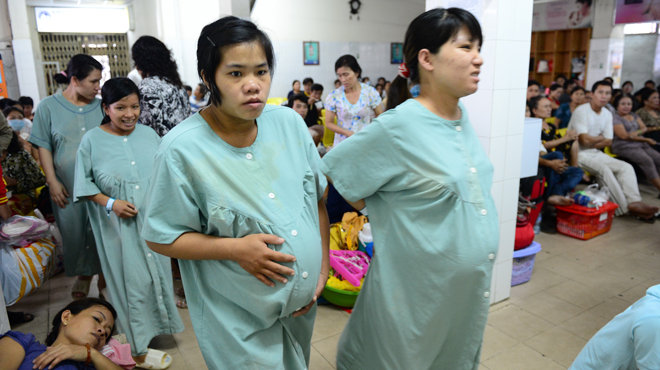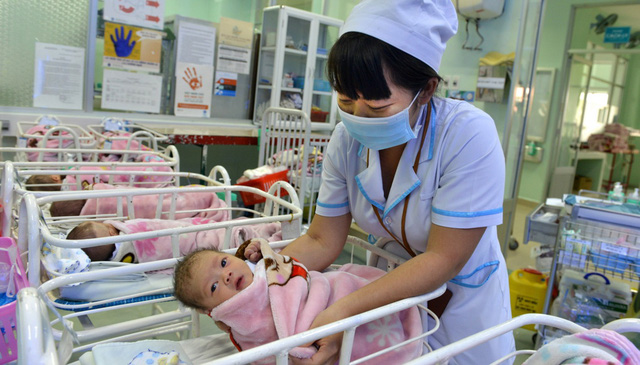Population experts have warned falling birth rates in Ho Chi Minh City - Vietnam’s most populous city - could spell disaster for economic growth and welfare systems in the southern metropolis.
Ho Chi Minh City has a permanent population of nine million and a population density of 4,363 people per square kilometer, the highest among all Vietnamese provinces and cities, according to a 2019 population census.
Those numbers may, however, eventually decrease as the city’s residents continue to demonstrate a growing aversion to the idea of giving birth.
According to statistics from the municipal Population and Family Planning Department, Ho Chi Minh City's total fertility rate (TFR) in 2018 was 1.33 children, significantly lower than Vietnam's replacement-level fertility of 2.10 children.
TFR is defined as the average number of children that are born to a woman over her lifetime. Replacement-level fertility is the TFR at which women give birth to enough babies to maintain population levels.
Ho Chi Minh City’s TFR has been steadily declining for the past 15 years. For comparison, the TFR in 2004 was 1.59.
Isolated recoveries were recorded in 2008 and 2013, when the city’s TFR climbed to 1.63 and 1.68 children, respectively, due to them being widely considered auspicious years to give birth according to the Vietnamese horoscope.
 |
| Doctors help a woman deliver her baby at the Tu Du Hospital in Ho Chi Minh City. Photo: Duyen Phan / Tuoi Tre |
Life and work pressures, late marriage, late childbirth and an overall aversion to giving birth have all contributed to the city’s falling birth rate, said Pham Chanh Trung, deputy director of the municipal Population and Family Planning Department.
“Higher education levels, improved living conditions, the growth in popularity of ‘trendy’ lifestyles, and the enjoyment of childless life are other contributing factors,” Trung said.
H., a 32-year-old married woman in Thu Duc District, told Tuoi Tre (Youth) newspaper she could only afford to have one child despite wanting more due to the high cost of living in Ho Chi Minh City.
“Many married couples in Ho Chi Minh City are migrants from other provinces so they don’t have parents with them to take care of their children and the cost of hiring a caretaker is quite high,” H. said.
“If both parents work, there’s no one around to take care of the children,” she added.
H. added that modern women are less keen on having children because they pay more attention to looking after themselves, including investing their time in travel, taking care of their appearance, developing their careers, and socializing with friends.
 |
| Expectant mothers crowd Tu Du Hospital in Ho Chi Minh City in this photo taken on September 30, 2012. Photo: Tuoi Tre |
Grave consequences
Ho Chi Minh City should seriously worry about its falling birth rate, Trung said.
Situations in other countries have shown that once a country’s birth rate has dropped too low, government measures have little impact on bringing the number up again, even with costly campaigns, he added.
A low and falling birth rate leads to a quickly aging population, which places pressure on the city’s welfare system including pensions, health insurance, and social security, Trung said.
Having a lower working age population, especially young professionals, will gravely affect Ho Chi Minh City’s socio-economic growth, the population expert warns.
Rather than spending money on improving the quality of its population, the city will have to set aside a large chunk of its budget to encourage childbirth instead, he explained.
 |
| A newborn baby at the Tu Du Hospital in Ho Chi Minh City. Photo: Duyen Phan / Tuoi Tre |
A child who is raised by two parents and four grandparents today will have to bear the burden of taking care of six dependents on their own tomorrow, he said.
“Giving birth is no longer a private issue of each family, but has become a matter on which a nation’s survival depends,” Trung said.
Since the 1960s, Vietnam has implemented a two-child policy that emphasizes the goal of having no more than two children in each family, with those working in the public sector facing monetary fines for exceeding the limit.
The policy has dramatically brought down the country’s fertility rate to three children per woman in the 1980s and two children per woman from 2005 until now.
Since 2017, couples in Ho Chi Minh City have been encouraged to make the most out of the decades-old two-child policy as the city persistently reports the lowest fertility rate in the country.
Like us on Facebook or follow us on Twitter to get the latest news about Vietnam!























































